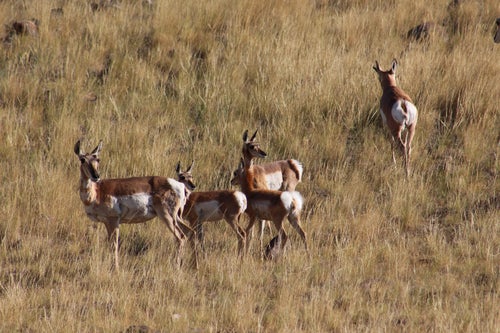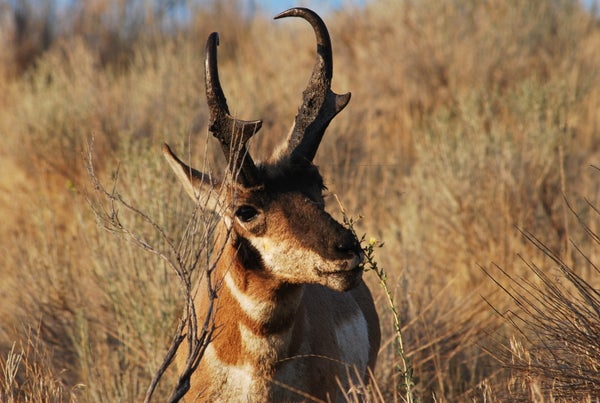This article was published in Scientific American’s former blog network and reflects the views of the author, not necessarily those of Scientific American
When I’m itching for a quick trip away from Salt Lake City, I often drive up the highway to Antelope Island. The largest of the islands within the Great Salt Lake, the patch of land is so named because explorers John Fremont and Kit Carson shot a pronghorn – commonly called “antelope” – there during a visit in 1845. After that, the island changed hands multiple times, but since 1981 the Utah state park has been home to bighorn sheep, bison, and, of course, the island’s namesake animal. From an evolutionary perspective, though, the park should probably be called Giraffoid Island.
Pronghorn are not antelope. Admittedly, they bear a fleeting and superficial resemblance to the diverse bovids, but Antilocapra americana is actually part of a unique group of ruminants more closely related to giraffes than impala and addax.
The origins of pronghorn are still murky. As paleontologist Edward Byrd Davis explained in his review of the family in the comprehensive Evolution of Artiodactyls volume, the group popped up with a burst of diversity around 17 million years ago and continued to proliferate until about 10,000 years ago. Antilocapra is the only remaining species within its family.
On supporting science journalism
If you're enjoying this article, consider supporting our award-winning journalism by subscribing. By purchasing a subscription you are helping to ensure the future of impactful stories about the discoveries and ideas shaping our world today.
A great deal of taxonomic and systematic revision remains to be done among the fossil members of the group, Davis argued, but it’s clear that these mammals are united by their peculiar horns. Covered in a kind of velvet in the earliest forms, and a keratinous sheath in later species, pronghorn ornamentation has always been based on a straight bony core that branches off into tines. Some, like Paracosoryx, had adornments that resembled those of today’s pronghorn, while the horns of the truly bizarre Ilingoceros spiraled in a twisted tower far above the herbivore’s skull.

Pronghorn in Wyoming. Credit: Brian Switek
The ornaments of pronghorn confounded generations of mammalogists who tried to figure out just what sort of hoofed beast the antilocaprids were. Much like true antelope, the horns of Antilocapra are covered in a tough sheath. Unlike antelope, however, the forked horns of Antilocapra grow and shed every year. Some researchers used this characteristic, as well as skeletal features, to argue that pronghorn are cousins of deer within a group called the Cervoidea. But their actual affiliation is even stranger.
Based on genetic evidence from living ruminants, molecular studies have found that Antilocapra is most closely related to modern giraffids (namely, the okapi and giraffe). Together, Antilocapra and the giraffids comprise the living extent of the Giraffoidea, a group outside the split between antelope and deer. This may explain why the horns of Antilocapra seem to have characteristics of both groups. Pronghorn evolved independently of antelope and deer, and whatever remembrances their ornamentation has to bovid horns or cervid antlers is a result of convergent evolution stemming from a more ancient common ancestor.
Pronghorn aren’t some wayward form of African antelope. They are charismatic, strange beasts that have a touch of the prehistoric about them. When I watch them walk along the roadside or browse among the sunflowers in the August heat on Antelope Island, I’m seeing the last remaining thread of a long evolutionary tapestry.
References:
Davis, E. 2007. “Family Antilocapridae”, pp. 227-240, in Prothero, D., and Foss, S., eds., The Evolution of Artiodactyls. Baltimore: Johns Hopkins University Press.
Hernández Fernández, M., Vrba, E. 2005. A complete estimate of the phylogenetic relationships in Ruminantia: a dated species-level supertree of the extant ruminants. Biological Reviews. 80: 269-302
Solounias, N. 1988. Evidence from horn morphology on the phylogenetic relationships of the pronghorn (Antilocapra americana). Journal of Mammalogy. 69, 1: 140-143
[This post was originally published at National Geographic.]
